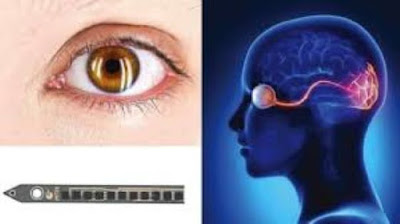Elon Musk’s Company Unveils Groundbreaking Eye Technology: A Leap Toward Restoring Vision
In a world where technological advancements are rapidly reshaping the landscape of medical science, Elon Musk’s company, Neuralink, has recently made headlines with its revolutionary development in eye technology. This new innovation aims to address vision loss and potentially restore sight, marking a significant milestone in the intersection of neuroscience and biotechnology.
1. The Revolutionary Eye Technology: An Overview
Elon Musk’s Neuralink, renowned for its pioneering work in brain-machine interfaces, has now turned its attention to one of the most profound challenges in medical science: vision restoration. The latest technology developed by Neuralink promises to transform the lives of millions suffering from visual impairments by harnessing the power of advanced neural interfaces.
What Is the New Eye Technology?
The technology involves an implantable neural device that interfaces directly with the visual cortex of the brain. This device is designed to bypass damaged or dysfunctional parts of the eye and optic nerve, sending visual information directly to the brain. By stimulating specific neural pathways, the device aims to restore a degree of vision to individuals who have lost their sight due to conditions such as macular degeneration or retinal damage.
2. The Science Behind the Innovation
At the core of Neuralink’s new eye technology is a sophisticated neural interface system that integrates with the brain’s visual processing centers. This system includes several key components:
Neural Implants
- Design and Function: The neural implants are tiny, flexible electrodes that are surgically implanted into the visual cortex. These electrodes are designed to read neural signals and stimulate specific neurons associated with vision.
- Precision and Safety: Advanced materials and surgical techniques ensure that the implants are both precise and biocompatible, minimizing risks and enhancing effectiveness.
Visual Information Processing
- Signal Transmission: The technology converts visual information from an external camera or sensor into electrical signals that are transmitted to the neural implants.
- Neural Stimulation: The implants then stimulate the neurons in the visual cortex, allowing the brain to interpret these signals as visual images.
User Interface
- External Components: A compact external device captures and processes visual information, which is then transmitted wirelessly to the neural implants.
- Adaptive Learning: The system is designed to adapt to the individual’s neural responses, improving visual perception over time.
3. Potential Impact and Benefits
The potential benefits of Neuralink’s eye technology are far-reaching, offering hope to millions affected by vision loss. Here’s how this breakthrough could make a difference:
Restoring Sight
- Vision Recovery: For individuals with severe vision loss, this technology offers a chance to regain some level of sight, improving their quality of life and independence.
- Enhanced Visual Perception: The system may provide improved visual clarity and color perception, which can be tailored to the specific needs of the user.
Advancing Medical Science
- Pioneering Research: Neuralink’s innovation could pave the way for further advancements in neural interfaces and brain-computer technologies, potentially leading to new treatments for other neurological conditions.
- Collaboration Opportunities: The technology opens up opportunities for collaboration with research institutions and medical professionals to refine and expand its applications.
Empowering Individuals
- Increased Independence: Restoring vision can significantly enhance an individual’s ability to perform daily tasks, engage in activities, and interact with their environment.
- Improved Quality of Life: Beyond the practical benefits, the emotional and psychological impact of regaining sight cannot be overstated, offering renewed hope and confidence.
4. Challenges and Considerations
While Neural ink's eye technology represents a groundbreaking achievement, there are several challenges and considerations to address:
Technical Challenges
- Long-Term Reliability: Ensuring the long-term functionality and reliability of the neural implants is crucial for sustained vision restoration.
- Integration with Neural Pathways: Achieving seamless integration with the brain’s visual processing centers requires ongoing research and refinement.
Ethical and Accessibility Concerns
- Ethical Implications: The development and deployment of such advanced technology raise ethical questions regarding its use, accessibility, and potential disparities.
- Cost and Accessibility: Making the technology accessible to a broad population, including those with limited financial resources, is essential for its widespread impact.
Regulatory Approval
- Clinical Trials: Rigorous clinical trials and regulatory approvals are necessary to ensure the safety and efficacy of the technology before it becomes widely available.
5. Looking Ahead: The Future of Vision Restoration
Neuralink’s new eye technology is a testament to the potential of modern science and engineering to tackle complex medical challenges. As the technology progresses through clinical trials and real-world applications, it holds promise for transforming the lives of individuals with vision impairments.
Future Developments
- Continued Innovation: Ongoing research and development will focus on enhancing the technology’s capabilities, improving user experience, and expanding its applications.
- Broader Implications: The success of this technology could lead to new breakthroughs in other areas of medical science, including treatments for neurological disorders and brain-computer interfaces.
Conclusion: A New Era of Vision Restoration
Elon Musk’s Neuralink has once again demonstrated its commitment to pushing the boundaries of technology with its revolutionary eye technology. By offering a potential solution for vision restoration, Neuralink is not only addressing a critical need but also paving the way for future innovations in medical science.
As we look toward the future, the ongoing development and refinement of this technology hold the promise of a world where vision loss is no longer an insurmountable barrier, and individuals can reclaim their sight and their lives.





